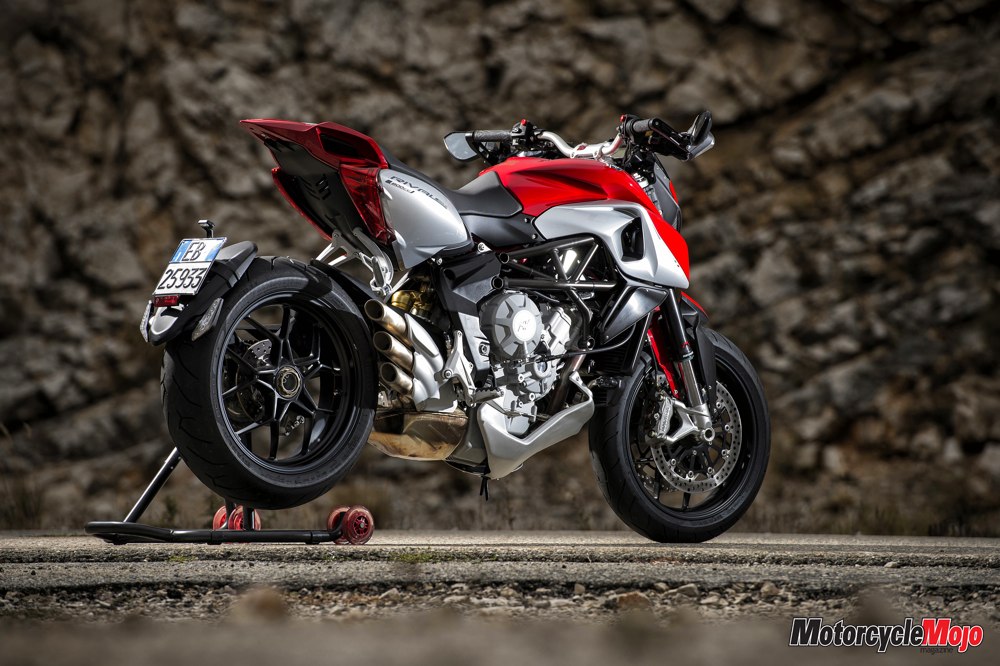Looking for a mid-size bike that offers high performance and knockout good looks? Here’s a pair of sleek Italian beauties that seem to have it all
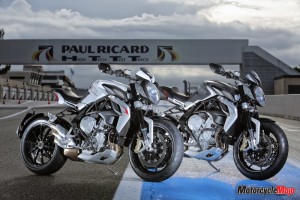 MV Agusta is the David to all the motorcycle-manufacturing Goliaths out there. It is a small, family-run company competing in a field dominated by huge, multinational conglomerates. In fact, the company produced just three models in 2009. But it’s growing rapidly, with 14 models expected by the end of 2014. The big turnaround came with the introduction of a quartet of mid-displacement triples. First came the F3 800 supersport, introduced in early 2013, followed later in the year by the Brutale 800 naked bike. More recently, MV Agusta introduced the motard-inspired Rivale 800, followed by the Brutale 800 Dragster, both of which Motorcycle Mojo was invited to ride in the south of France.
MV Agusta is the David to all the motorcycle-manufacturing Goliaths out there. It is a small, family-run company competing in a field dominated by huge, multinational conglomerates. In fact, the company produced just three models in 2009. But it’s growing rapidly, with 14 models expected by the end of 2014. The big turnaround came with the introduction of a quartet of mid-displacement triples. First came the F3 800 supersport, introduced in early 2013, followed later in the year by the Brutale 800 naked bike. More recently, MV Agusta introduced the motard-inspired Rivale 800, followed by the Brutale 800 Dragster, both of which Motorcycle Mojo was invited to ride in the south of France.
At the heart of both machines is the company’s new liquid-cooled, 798 cc, inline-triple. As in the other MV triples, the crankshaft rotates backwards (clockwise when looking at the bike from the left), which is said to quicken turning transitions. Both bikes share the same engine, although tuning is very slightly different, both claiming 125 hp, with 62 ft-lb of torque for the Rivale and 60 ft-lb for the Dragster. Although the same engine is found in the F3 800, here it’s in a higher state of tune, producing 148 hp and 65 ft-lb of torque. The engine is mated to a close-ratio, six-speed gearbox through a multi-plate wet clutch that does not have a slipper feature, though an electronic quick shifter is standard on both machines.
Both models also have a similar electronics package, which includes four selectable ride modes – Normal, Sport, Rain and Custom, the last one rider tunable – and eight levels of traction control. Where they don’t share electronics is in the braking system; the Dragster has switchable ABS as standard equipment, while ABS is not available, even as an option, on the Rivale – at least, not yet.
Rivale
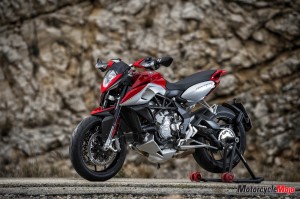 The Rivale 800 is new from the ground up, and not just a Brutale with different bodywork. The bike was first penned in 2008, with the actual work beginning two years ago. As with other products in MV’s portfolio, the Rivale is a stunning looker from any angle. Its styling is motard-inspired, and there are some unintentional and interesting design cues that chief designer Adrian Morton noticed only after looking at photographs of the bike. From the side, the tailpiece looks like a stylized, art-deco bird; looking at it directly from the rear, you’ll see an open-mouthed snake; back off a bit from the rear, and you can see a jumping frog.
The Rivale 800 is new from the ground up, and not just a Brutale with different bodywork. The bike was first penned in 2008, with the actual work beginning two years ago. As with other products in MV’s portfolio, the Rivale is a stunning looker from any angle. Its styling is motard-inspired, and there are some unintentional and interesting design cues that chief designer Adrian Morton noticed only after looking at photographs of the bike. From the side, the tailpiece looks like a stylized, art-deco bird; looking at it directly from the rear, you’ll see an open-mouthed snake; back off a bit from the rear, and you can see a jumping frog.
A couple of other discreet details reveal how MV Agusta goes about design just a bit differently than other manufacturers. On top of the tiny tailpiece, there’s a plastic panel that, when removed, reveals a mounting point for future accessories, like a small luggage rack or top-case mount. The licence-plate light is a cute little LED item that looks more like a reading light. The folding bar-end mirrors are a design first seen on the Ducati Hypermotard. There are other visual similarities between the two bikes, but the similarities end when you start the Rivale and hear its growling exhaust.
Like the Dragster, the Rivale uses a steel trellis main frame that incorporates a cast-aluminum rear section containing the swingarm pivot. The bike has slightly different steering geometry than the Dragster, using a 30 mm longer wheelbase at 1410 mm, half a degree more rake at 24.5 degrees, 10 mm more trail at 105 mm. Like the Dragster, a 43 mm inverted fork and single Sachs shock, both fully adjustable, provide suspension duties, though the Rivale has slightly longer suspension travel. Claimed dry weight is 178 kg (392 lb.).
The Rivale 800 was launched in Vence, France, and usually when we’re guided on a press ride, our lead rider allows us to get accustomed to the machines by beginning slowly on wider, flowing roads and working up to speed for the tighter stuff. But as I mentioned earlier, MV Agusta does things a bit differently. Within a few turns of the hotel entrance, we were hammering the bikes into switchbacks and hairpins at an experts-only pace.
The seating position is forward biased, much like the first-generation Hypermotard was before Ducati moved the perch rearward, inviting an aggressive pace. The Rivale responds to steering inputs with precision and poise. Steering effort is light and remains neutral through turns, yet the bike is surprisingly stable and free of the unintentional weaving usually attributable to wide handlebars.
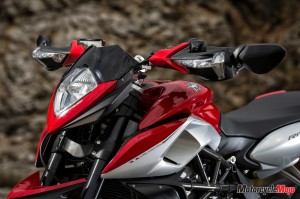 MV Agustas use ride-by-wire throttle control, and throttle response on previous models had been quite abrupt. MV Agusta’s test riders have accumulated 250,000 kilometres developing the Rivale, and that exhaustive tuning work was evident as soon as I let the clutch out. Throttle response is linear and easily manageable, even in the most aggressive Sport mode. To select a ride mode, all you have to do is hit the starter button while the engine is running to scroll through the different modes appearing in the digital dash display, select the one you want, and that’s it.
MV Agustas use ride-by-wire throttle control, and throttle response on previous models had been quite abrupt. MV Agusta’s test riders have accumulated 250,000 kilometres developing the Rivale, and that exhaustive tuning work was evident as soon as I let the clutch out. Throttle response is linear and easily manageable, even in the most aggressive Sport mode. To select a ride mode, all you have to do is hit the starter button while the engine is running to scroll through the different modes appearing in the digital dash display, select the one you want, and that’s it.
The engine has a super-wide, flat powerband, and it can accelerate smoothly and with surprising grunt from as low as 50 km/h in top gear. The powerband is so wide that you can’t really select a wrong gear – it’s just a matter of how hard you want to accelerate out of corners. Select a higher gear or two for more progressive acceleration, or leave it in a lower gear to blast out, letting the engine scream in its upper rev range. And it seems to rev forever; I tried on a couple of occasions to get the engine to bump off the rev limiter, but it just kept pulling – at least until the next corner. The traction control was set to level four of eight, and I found no reason to change it.
Engine vibration is minimal, and at normal highway speeds, it is almost imperceptible. It’s only in the upper revs that you’ll feel some unobtrusive buzzing. First gear is tall, and although clutch effort is light, it needs a bit of slipping to get going. The folding mirrors work very well, providing a clear, elbow-free rear view, though engine buzzing blurred images. If you don’t like the folding versions, you can order a set of conventionally mounted billet mirrors, though I was told all you’ll see in those is your elbows.
I sampled each ride mode except Custom, and settled on Sport; throttle response was easily manageable in all of them. If you own a current or older MV that has earlier mapping software and an abrupt throttle, do not fret. MV Agusta will update the throttle maps of previous models for free through their dealers.
This bike’s suspension will appeal to a wide variety of riders. Unlike sporty naked bikes, MV Agusta refrained from equipping the Rivale with supersport-stiff suspension, and it features full adjustability front and rear. Initially, the rear suspension was too soft on the rebound, and the bike bobbed a bit through turning transitions; three-quarters of a turn on the rear rebound screw did the trick.
MV Agusta seems intent on remaining an exclusive maker of low-volume, premium products. And the Rivale 800 is a premium bike, as reflected in its $16,995 price tag. Company CEO Giovanni Castiglioni believes the Rivale 800 is as significant a model for the company as the F4 was when it was introduced. I think it’s the best MV Agusta has produced to date.
Brutale
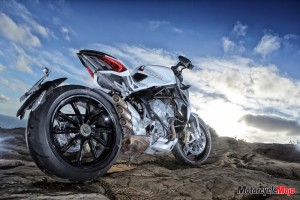 Although I’d assumed the Dragster 800 was an entirely new bike when I saw some leaked photos of it on the Internet, it’s not. It shares the frame, swingarm, fork, suspension, brakes, engine, engine tuning and some of the bodywork with the Brutale 800. Different is the much abbreviated rear subframe and seat, the absence of a tailpiece, and a fatter, 200-series rear tire mounted on a 6-inch wheel, as opposed to the 180-series on a 5.5-inch rim for the Brutale.
Although I’d assumed the Dragster 800 was an entirely new bike when I saw some leaked photos of it on the Internet, it’s not. It shares the frame, swingarm, fork, suspension, brakes, engine, engine tuning and some of the bodywork with the Brutale 800. Different is the much abbreviated rear subframe and seat, the absence of a tailpiece, and a fatter, 200-series rear tire mounted on a 6-inch wheel, as opposed to the 180-series on a 5.5-inch rim for the Brutale.
Engineers didn’t conceive the bike to fool people into thinking it’s different than the Brutale, and according to the company’s CEO, Giovanni Castiglioni, it was designed to “just offer another choice.” Fair enough: a sort of factory custom, assembled in Italy to save you the time and effort of building it yourself. Visually, the result is quite dramatic, its stubby rear end giving the appearance that the swingarm has been lengthened when it hasn’t been. Wheelbase is the same as the Brutale’s at a rather stubby 1380 mm, as is claimed dry weight at 167 kg.
Aside from the stubby hindquarters, the Dragster also replaces the Brutale’s tubular aluminum handlebar with a pair of cast-aluminum handlebars adjustable in three positions, offering seven degrees or 40 mm of fore and aft movement. Be forewarned, though: The sliver of a pillion seat might lead to couples therapy sessions, so think carefully about carrying your better half back there. Sometimes things don’t go as planned during press launches.
We were originally supposed to spend a day riding in the mountainous regions one hour east of Marseille, France, and a second day lapping at the famed Circuit Paul Ricard. Heavy rain and single-digit temperatures, however, forced the organizers to postpone the street ride. Fortunately, the next day was sunny and warmer, and we enjoyed a condensed schedule that combined the road ride and track sessions.
We began at the track, where the Dragster belied its name by handling like anything but. If you’re six-foot or taller, you’ll find the Dragster’s ergonomics a bit cramped – not uncomfortably so, but it is a small bike. Steering is exceptionally light and borderline twitchy, though it never shook its head or weaved through the fast sweepers. The bike did have a tendency to resist tightening up its arc through a turn, especially in the high-speed, decreasing-radius Turn 11, where you had to turn in harder and lean further as the turn tightened before opening up at the exit. This was no doubt an aftereffect of the fat rear tire.
I set the ride mode to Sport for the most aggressive throttle response, and like the Rivale, throttle modulation was quite smooth, even at low speeds. Power delivery was wide and flat, with no peaks or valleys in acceleration throughout the rev range. There’s no slipper clutch, and the Dragster has copious amounts of engine braking, though it never exhibited wheel hop, even when braking hard for a V-shaped hairpin strategically placed at the end of the 230 km/h front straight. Very tight turns do confuse the Dragster a bit, causing it to run a bit wide at the exit, again a byproduct of the fat rear tire.
I also selected the third level of traction control before minimum intervention, and it only kicked in during a fast, left-to-right turning transition, as the bike stood up while hard on the gas. There is no visual indication on the gauge cluster to tell you the TC is working, but you can feel a slight hesitation in the power delivery as it reacts to wheel spin. Like the Rivale, the Dragster has one of the smoothest-shifting transmissions I’ve sampled recently. It shifts with light lever effort, whether using the quick-shift or not, and ratios are well matched to the engine.
After a morning of lapping, we moved to the roads of the Côte d’Azur, which were even more revealing than the track. First, I noticed that the fold-out mirrors provided an unobstructed rear view, though they blurred when engine speed exceeded 4000 rpm. Fortunately, the engine buzzing was otherwise unobtrusive. Next, I noticed that our Italian lead rider, the same fellow who had led the Rivale test ride a couple of weeks earlier, had set a pace that made our morning track sessions seem like a warm-up. And the roads! Almost immediately out of the racetrack parking lot, we turned onto a tight, winding and impeccably paved stretch of pavement wide enough for about a car and a half, and a small car at that.
We maintained a tight, seven-bike formation at unpublishable speeds, and the Dragster once again proved that maybe its makers should have chosen a different name. The light steering I’d noticed at the track was indeed light, yet remained borderline twitchy on the road. But the Dragster went almost exactly where I wanted it to; the only time it required a bit more of my attention was in tight, first-gear hairpins, of which there were plenty. Here, I just needed to keep constant pressure on the inside handlebar to keep my line tight.
A later ride on a Brutale 800 for comparison confirmed that this, too, was due to the fat rear tire. The Brutale’s steering was more neutral and precise, and the bike was more stable. The Dragster’s fat rear tire also dulled front-end feel a bit, making feedback a touch more vague – not uncomfortably so, but something you’d notice if you rode both bikes back to back.
With the fuelling sorted, the 798 cc inline-triple is absolutely marvelous – it’s no wonder those MV folks are putting it in almost everything they make. It pulls relentlessly to redline, making gear changes optional. At the track, I also had a chance to ride the F3 800, and its added horsepower would have made the Dragster even more fun to ride – but really only at the track. On the street, 125 ponies proved more than enough, and its smooth, torquey power delivery proved a boon, whether blasting high-speed along winding mountain roads, or at more sedate speeds around town.
Overall, the bike’s designers did a very good job of managing the compromised handling a fat tire imposes on a chassis. They must, after all, meet the changing demands of riders, and fat rear tires are still in. The real issue is that this small, family-owned business is beginning to produce motorcycles that will be competitive against much bigger players, and the model line-up continues to grow (there’s another unannounced model coming later this year).
The Dragster retails for $15,995, which is $1600 more than the Brutale. That’s a considerable amount, but like Castiglioni said, it offers a different choice. If you don’t want to spend the extra dough but want exclusivity in all its Italian nakedness, go for the Brutale. It handles a bit better and shares many of its features with its Dragster brother. But the Dragster looks badass, and it does so while handling better than it should, considering its rear-end transformation.
According to Castiglioni, MV Agusta now outsells Aprilia in Europe, and demand is increasing. I have no doubt that MV Agusta sales will continue their upward trend; the bikes are getting better with each model launched, and they are among the best-looking machines on the market. Their company’s only limiting factor is a small distribution network. Numbers presented during one of the morning press briefings revealed that sales increases were directly linked to European countries where the distribution network was broadened. With more dealers here, that trend would surely follow in this country.









